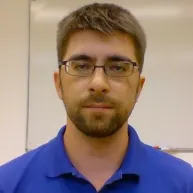Complex Dynamical Systems
We can think of a dynamical system as a function f(x), with which, given an initial state x0, one can compute x1=f(x0), x2=f(x1), x3=f(x2), and so on. Each of the inputs (x0, x1, x2) can be a number or a vector of numbers.
One of the recurring themes in Igors Gorbovickis’ research is the application of methods from complex analysis to the study of dynamical systems. This means that the inputs can be complex numbers, containing both real and imaginary parts. Even though this makes the dynamical system more complicated, it allows for the introduction of various powerful methods of complex analysis.
Prof. Gorbovickis is also studying the mechanisms behind the Feigenbaum-Coullet-Tresser type (FCT-type) universalities. In the late 1970s mathematical physicist Mitchell Feigenbaum (and independently Pierre Coullet and Charles Tresser) empirically observed that the transition from regular to chaotic dynamics through cascades of period doubling bifurcations happens according to a certain “universal scaling law”. More specifically, they discovered that the small scale structure of the bifurcation loci in a certain large class of one-parameter families of real one-dimensional dynamical systems with a critical point is independent of the specific family.
A large number of experiments highlighted the importance of their discovery, and showed that the period-doubling scenario occurs in many natural systems, such as the onset of turbulence in fluid flow, oscillations in chemical reactions, and electrical networks, to name a few.
Although a lot of progress has been made by mathematicians in understanding the reasons behind the FCT-type universality phenomena, there are cases in which we still lack a complete picture. Igors Gorbovickis’ research aims to explain the FCT-type universalities in these cases by adopting appropriate complex analytic methods.
In other ongoing research projects, Igors Gorbovickis studies the distribution of critical points of the multiplier maps in the space of rational maps on the complex plane; renormalization and related rigidity and universality phenomena for Lorenz mappings; and the study of the Hausdorff dimension of some Julia sets.
- Five refereed articles published or accepted for publication in 2019–2022. Two articles are under review for journal publications.
- Co-organized the Hanseatic Dynamical Systems Day IV at Constructor University in December 2019.
- In joint work with Michael Yampolsky at the University of Toronto, Prof. Gorbovickis obtained the first C1+α-rigidity result for multicritical circle maps with an arbitrary number of critical points.
- In joint work with Artem Dudko (Institute of Mathematics of the Polish Academy of Sciences) and Warwick Tucker (Monash University, Australia), Prof. Gorbovickis significantly improved the known lower bounds on the Hausdorff dimension of some real-symmetric Julia sets.
Igors Gorbovickis’ research is supported by the DFG, which provides funding for one postdoctoral position. Prof. Gorbovickis collaborates with mathematicians from the United States, Canada, Sweden, Australia and Poland.
- (with A. Dudko and W. Tucker) Lower bounds on the Hausdorff dimension of some Julia sets, (submitted) 2022.
- (with M. Yampolsky) Rigidity of analytic and smooth bi-cubic multicritical circle maps with bounded type rotation numbers, (submitted) 2021.
- (with T. Firsova) Accumulation set of critical points of the multipliers in the quadratic family, (to appear in Ergodic Theory Dynam. Systems) 2020.
- (with D. Gaidashev) Complex a priori bounds for Lorenz maps, (to appear in Nonlinearity) 2020.
- (with T. Firsova) Equidistribution of critical points of the multipliers in the quadratic family, (to appear in Adv. Math.) 2019.

